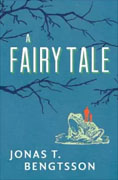A Fairy Tale
Jonas Bengtsson
book reviews:
· general fiction
· chick lit/romance
· sci-fi/fantasy
· graphic novels
· nonfiction
· audio books
· author interviews
· children's books @
curledupkids.com
· DVD reviews @
curledupdvd.com
newsletter
win books
buy online
links
home
for authors
& publishers
for reviewers

 |
A Fairy Tale Jonas Bengtsson House of Anansi Press Paperback 352 pages March 2015 |
|
A Fairy Tale
The frog stares at them. It’s enormous; its skin is green and knobbly. ‘So you want to get across?’ it asks, and grins. Its echoing laughter stinks of rotten water; its jaw is so big it could easily swallow a car. The King and the Prince look at the lake. The far shore has disappeared in the thick fog. ‘I won’t eat you,’ the frog says. ‘I promise’ … I lie on my bed, holding my breath. The toilet being flushed downstairs becomes a huge pike splashing about in the murky water. Next door’s television becomes bird-song in the trees behind us.” (Bengtsson 89)Children are easily swept away by their imaginations, an ability that is too often lost in adulthood. Yet the narrator’s father also seems increasingly out of touch with reality. He tells stories to his son of “the King” and “the Prince” who journey to destroy the “White Queen” and the “White Men” who work for her. Clearly, the father is preparing his son for something, but this danger is always vague and never explained fully, though it is clarified later in the novel. Then, without warning, the fairy tales diminish and eventually disappear as the book progresses. This parallels how growing up stymies childhood imagination, but without these tales, the book becomes hundreds of pages of a dull narrative of daily life as experienced by a child. Yes, the on-the-run, drifter lifestyle the father and son have is more interesting than the daily routine of an average child, but the reader waits constantly for something to happen. As the years and the pages pass slowly, there is an endless amount of characters introduced but never developed. When combined with a lack of conflict, and streamed through the limitations of a child’s narrative, this makes it difficult to care about the many individuals encountered by the narrator and his father. When the increasingly unstable father does something unexpected, the narrative abruptly jumps seven years and the narrator is now a teenager living with a foster family. This portion of the novel is where the story finally becomes interesting. The narrator’s life at sixteen portrays usual elements of fictional adolescents: trouble at school and experimentation with drugs and sex. These adolescent prosaicisms may be predictable, but at least they break from the childhood routine that until this point is painstakingly drawn-out. As reality absorbs the narrator’s life, Bengtsson manages to reclaim small portions of the fairytale: the narrator journeys far away to visit estranged members of his father’s family. Thus, the narrator (the “prince”) is on a quest to discover his father’s origins and the origins of his own bizarre childhood. While the narrator discovers more underdeveloped characters and vague events, the reader can enjoy Bengtsson’s description of bicycles. These seemingly ordinary objects that so often represent freedom and leisure symbolically mirror the disrupted and ruined childhood that the narrator experiences. When the narrator is young, there is the following description: “A rusty child’s bicycle hangs in the air, lifted up by the branches that envelop it” (150). Then, when the adolescent narrator gets intoxicated with a girl at a party: “There’s a discarded tricycle on the lawn, its front wheel is pointing up to the sky. At the bottom of the garden is a wooden playhouse painted red.” (281). Various types of bicycles appear at several other times in the story, almost always as forgotten relics that comment on childhood. These well-worded fragments of figurative language attest to the ability of Bengtsson’s writing, but they do not excuse the story’s slow development with a resolution that, while not revealed here, is nevertheless a frustrating conclusion that seems to excuse deviant behavior. Bengtsson obviously believes, correctly, that childhood greatly influences our lives, but this readily-accepted fact–instead of a profundity about this fact–is all that he manages to convey. Not unexpectedly, A Fairy Tale Originally published on Curled Up With A Good Book at www.curledup.com. © Joshua Myers, 2015 |
|
|
|
 Click here to learn more about this month's sponsor! |
|
| fiction · sf/f · comic books · nonfiction · audio newsletter · free book contest · buy books online review index · links · · authors & publishers reviewers |
|
| site by ELBO Computing Resources, Inc. | |
 Initially, the fairy tales are interwoven with real-life events. With these descriptions, Bengtsson displays his talent for language and accurately assesses the thin line between fantasy and reality that is common among children. Take, for instance, the following passage:
Initially, the fairy tales are interwoven with real-life events. With these descriptions, Bengtsson displays his talent for language and accurately assesses the thin line between fantasy and reality that is common among children. Take, for instance, the following passage: